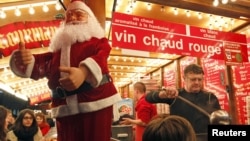STRASBOURG, FRANCE —
The French Alsatian city of Strasbourg has been on the map for years as a major tourist destination during the holidays, with close to two million visitors expected to have taken in the sights this season.
The main draw is its Christmas market, the oldest and one of the largest in Europe. The city spends $3.3 million a year on the market, a paltry sum compared to what it brings in, even in tougher economic times.
If there is one city in the world that rhymes with Christmas, it certainly is Strasbourg, the capital of the Alsace region.
Each year, the municipality coordinates 500 related events, strings dozens of kilometers of lights across the city and erects a 30-meter tree, cut in the nearby forests of the Vosges mountains.
The centerpiece of festivities, is Strasbourg’s Christmas market. Dating back to 1570, it is the oldest in Europe and boasting 300 chalets, it is certainly one of the largest.
“We’ve been here for six hours walking around," said Jacqueline Pal, from Los Angeles. She came with her daughter, who lives in Paris, and they are both raving about the experience.
“We have different markets, but it seems less commercial. I know, it’s about buying and selling, but the whole atmosphere is a lot different. There’s a whole joie de vivre.”
There is no question though that the market is big business. The city pours $3.3 million into holiday preparations and decorations each year and it has maintained this level of investment.
And this, because the period from the last weekend of November to Christmas will generate more than $210 million in benefits for Strasbourg and draw two million visitors.
Deputy mayor Robert Hermann says there is no better month in the year for restaurants and hotels.
For some artisans and businesses, the market accounts for up to half of their annual income and Hermann says they would struggle without this window on their work.
Preliminary reports indicate crowds and sales are down for this 442nd edition, but only slightly, and depending on the products they offer, some kiosks are naturally faring better than others.
Farmer Pierre-Henri Lenormand, who sells herbs and cheeses, like the regional Munster, reports he has done well.
The man who coordinates the city’s efforts, Renaud de Maillard, says he and the 15 project heads he supervises are already at work planning for next year. And there is talk of further exporting the market.
That’s right: Strasbourg already hosts a Christmas market in Tokyo and this year it launched in Moscow.
In 2013, there could be a Strasbourg Christmas market in New York City, near Rockefeller Center.
Deputy mayor Robert Hermann says in today’s race to attract foreign investment and qualified workers, it’s a way to showcase the city’s culture, businesses, research and innovation and quality of life.
And to do so in a more festive ambiance than the traditional trade shows allow.
The main draw is its Christmas market, the oldest and one of the largest in Europe. The city spends $3.3 million a year on the market, a paltry sum compared to what it brings in, even in tougher economic times.
If there is one city in the world that rhymes with Christmas, it certainly is Strasbourg, the capital of the Alsace region.
Each year, the municipality coordinates 500 related events, strings dozens of kilometers of lights across the city and erects a 30-meter tree, cut in the nearby forests of the Vosges mountains.
The centerpiece of festivities, is Strasbourg’s Christmas market. Dating back to 1570, it is the oldest in Europe and boasting 300 chalets, it is certainly one of the largest.
“We’ve been here for six hours walking around," said Jacqueline Pal, from Los Angeles. She came with her daughter, who lives in Paris, and they are both raving about the experience.
“We have different markets, but it seems less commercial. I know, it’s about buying and selling, but the whole atmosphere is a lot different. There’s a whole joie de vivre.”
There is no question though that the market is big business. The city pours $3.3 million into holiday preparations and decorations each year and it has maintained this level of investment.
And this, because the period from the last weekend of November to Christmas will generate more than $210 million in benefits for Strasbourg and draw two million visitors.
Deputy mayor Robert Hermann says there is no better month in the year for restaurants and hotels.
For some artisans and businesses, the market accounts for up to half of their annual income and Hermann says they would struggle without this window on their work.
Preliminary reports indicate crowds and sales are down for this 442nd edition, but only slightly, and depending on the products they offer, some kiosks are naturally faring better than others.
Farmer Pierre-Henri Lenormand, who sells herbs and cheeses, like the regional Munster, reports he has done well.
The man who coordinates the city’s efforts, Renaud de Maillard, says he and the 15 project heads he supervises are already at work planning for next year. And there is talk of further exporting the market.
That’s right: Strasbourg already hosts a Christmas market in Tokyo and this year it launched in Moscow.
In 2013, there could be a Strasbourg Christmas market in New York City, near Rockefeller Center.
Deputy mayor Robert Hermann says in today’s race to attract foreign investment and qualified workers, it’s a way to showcase the city’s culture, businesses, research and innovation and quality of life.
And to do so in a more festive ambiance than the traditional trade shows allow.








